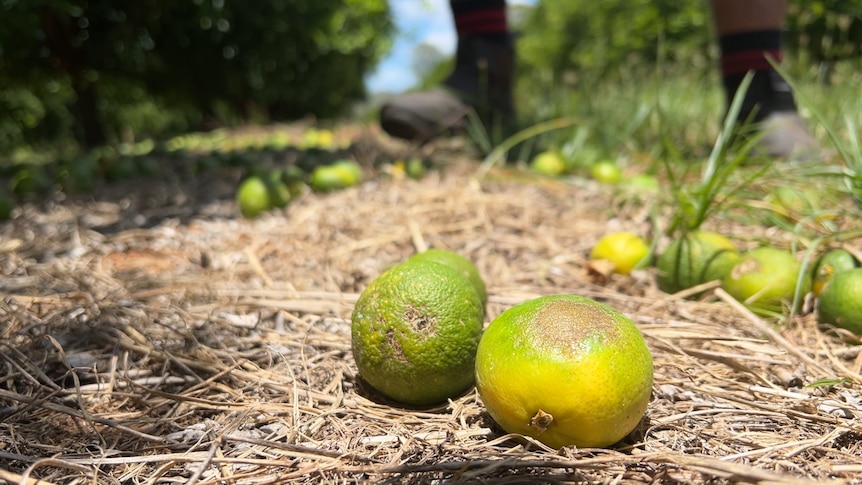Australia Weather News

Growers are removing damaged fruit now rather than waiting until harvest. (ABC Wide Bay: Grace Whiteside)
Walking through the rows of his citrus trees, Ken Roth looks at all the income he has just lost from the thousands of oranges and mandarins littering the ground.
"You can't do nothing with them when they're damaged like that," he said.
His workers are busy thinning the trees — a standard farming process of removing blemished fruit.
But this year his crop is down by 70 per cent because of a violent hailstorm late last year.
"If you don't get it off the tree you've got to put it through your processing plant, wash it, wax it, and then throw it out," Mr Roth explained.
The Roths are one of several producers in the North Burnett town of Gayndah, four hours' north of Brisbane, who are still counting the cost of hailstorms over the past few months.
"I came out here probably three hours after [the storm] and there was still ice laying under the trees," Mr Roth said.
"The worst thing was the wind.
"We had so much wind to just drive it right through from one side of the tree to the other, and now we've only got a tiny little bit [of undamaged fruit] on the northern side."
Fellow Gayndah grower Matt Benham lost more than half his crop across three farms in two storms over the Christmas-new year period.
"A good year for us is around 14,000 bins [of fruit] … and it'll be looking more like 6,000," he said.
Both growers are removing the severely affected fruit now, rather than sorting through the damaged citrus in the packing shed.
Fruit with light blemishes may be able to be sold to the wholesale market or as a lower-grade product.
Data from Citrus Australia shows the Southern Queensland region, which includes the Gayndah area, has 3,500 hectares of citrus trees with an export value of more than $170 million.
Limited protection measures
Mr Benham said hail was part of the farming gamble, but it was not worth installing netting or similar protection across his 70,000 hectares.
"Down south there is a lot of it and they're doing that for not only storm protection but for sunburn protection, better climate and that sort of thing," he said.
"In this more humid climate having netting in place would increase disease pressure. We need the air flow coming through."
At $60,000 a hectare Mr Benham said the pay-off was not yet there for his farm.
"You're talking the same value to put the netting up as what the country and the trees are," he said.
"If it was like a yearly guarantee [that you got hail] it would be a flip of the coin whether you spend the $60,000 a hectare, or you just don't do citrus anymore."
Market impact
Mr Benham said it had been shaping up to be a good season.
"A lot of the varieties around were going to be a fairly 'on' year and have quite good volumes so it might just buffer that out a little bit, maybe," he said.
"At the end of the day, it just sucks for the people that have been hit and you don't wish this on anyone."
Citrus Australia chief executive Nathan Hancock said the hail event would have a "marginal effect" on overall supply.
"But I think for those that are directly impacted, it has a very significant impact," he said.
Mr Hancock said it was a "kick in the guts" for affected growers.
"It's really isolating for the growers that it affects because it can literally be across the fence and not be affecting your property," Mr Hancock said.
"I think most growers are cautious about storms throughout the summer period and I guess it is a little bit late, but whenever you get hail it can be painful, it doesn't matter what time of year it is."
Mr Roth said he had been considering some drastic measures for his 23,000 trees.
"I was nearly thinking of ordering a bulldozer because I'm close to retirement and just putting the dozer through it," he said.
"But after a few weeks, I decided I'll have another go.
"I've spent a lifetime putting it here and I just couldn't put myself to putting the dozer through it yet."
ABC